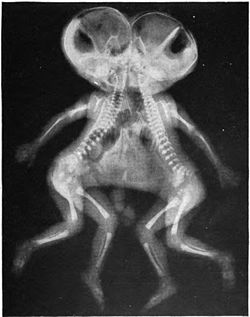Separation
Surgery to separate conjoined twins may range from very easy to very difficult depending on the point of attachment and the internal parts that are shared. [19] Most cases of separation are extremely risky and life-threatening. Though there have been a number of successful separations throughout history, in many cases, the surgery results in the death of one or both of the twins, particularly if they are joined at the head or share a vital organ. This makes the ethics of surgical separation, where the twins can survive if not separated, contentious. Alice Dreger of Northwestern University found the quality of life of twins who remain conjoined to be higher than is commonly supposed. [20] Lori and George Schappell and Abby and Brittany Hensel are notable examples.
The first recorded separation of conjoined twins took place in the Byzantine Empire in the 900s. One of the conjoined twins had already died, so the doctors of the town attempted to separate the dead twin from the surviving twin. The result was briefly successful, as the remaining twin lived for three days after separation. The next recorded case of separating conjoined twins was several centuries later, in Germany, in 1689. [21] [22] The first recorded successful separation of conjoined twins was performed in 1689 by Johannes Fatio. [23] Around this same time Dr. Böhm of Gunzenhausen separated his own children, a pair of omphalopagus or xiphopagus twins; the feebler twin died four days later, but the healthier one was still alive and well at age five, when the case was reported. [24] In 1955, neurosurgeon Harold Voris (1902-1980) [25] and his team at Mercy Hospital in Chicago performed the first successful operation to separate craniopagus twins (conjoined at the head), which resulted in long-term survival for both. [26] [27] [28] The larger girl was reported in 1963 as developing normally, but the smaller girl was permanently impaired. [29]
In 1957, Bertram Katz and his surgical team made international medical history performing the world's first successful separation of conjoined twins sharing a vital organ. [30] Omphalopagus twins John Nelson and James Edward Freeman (Johnny and Jimmy) were born in Youngstown, Ohio, on April 27, 1956. The boys shared a liver but had separate hearts and were successfully separated at North Side Hospital in Youngstown, Ohio, by Bertram Katz. The operation was funded by the Ohio Crippled Children's Service Society. [31]
Other successful separations of conjoined twins include that of the separation of Ganga and Jamuna Shrestha in 2001, who were born in Kathmandu, Nepal, in 2000. The 97-hour surgery on the pair of craniopagus twins was a landmark one which took place in Singapore; the team was led by neurosurgeons Chumpon Chan and Keith Goh. [32] The surgery left Ganga with brain damage and Jamuna unable to walk. Seven years later, Ganga Shrestha died at the Model Hospital in Kathmandu in July 2009, at the age of eight, three days after being admitted for treatment of a severe chest infection. [33]
Infants Rose and Grace Attard, conjoined twins from Malta, were separated in the United Kingdom by court order Re A over the religious objections of their parents, Michaelangelo and Rina Attard. The twins were attached at the lower abdomen and spine. The surgery took place in November 2000, at St Mary's Hospital in Manchester. The operation was controversial because Rose, the weaker twin, would die as a result of the procedure as her heart and lungs were dependent upon Grace's. However, if the operation had not taken place, it was certain that both twins would die. [34] [35] Grace survived to enjoy a normal childhood. [36]
In 2003, two 29-year-old women from Iran, Ladan and Laleh Bijani, who were joined at the head but had separate brains (craniopagus), were surgically separated in Singapore, despite surgeons' warnings that the operation could be fatal to one or both. Their complex case was accepted only because technologically advanced graphical imagery and modeling would allow the medical team to plan the risky surgery. However, an undetected major vein hidden from the scans was discovered during the operation. [37] The separation was completed but both women died while still in surgery.
In 2019, Safa and Marwa Ullah were separated at Great Ormond Street Hospital in London, England. The twins, born January 2017, were joined at the top of the head with separate brains and a cylindrical shared skull with the twins each facing in opposite directions to one another. The surgery was jointly led by neurosurgeon Owase Jeelani and plastic surgeon Professor David Dunaway. The surgery presented particular difficulties due to a number of shared veins and a distortion in the shape of the girls' brains, causing them to overlap. The distortion would need to be corrected in order for the separation to go ahead. The surgery utilized a team of more than 100 including bio engineers, 3D modelers and a virtual reality designer. The separation was completed in February 2019 following a total of 52 hours of surgery over three separate operations. The family returned to their home in Pakistan in October 2020, though one of the twins had a stroke during surgery which could make her unable to walk for the rest of her life. [38] [39] [40]






